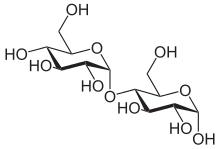Maltose/ja: Difference between revisions
Created page with "== 歴史{{Anchor|History}} == マルトースはAugustin-Pierre Dubrunfautによって発見されたが、この発見は1872年にアイルランドの化学者であり醸造家でもあるCornelius O'Sullivanによって確認されるまで広く受け入れられることはなかった。名称は麦芽に由来し、糖類の名称に用いられる接尾辞「-ose」と組..." |
Created page with "== 構造と命名法{{Anchor|Structure and nomenclature}} == 炭水化物は一般に、糖のサブユニットの数によって単糖、オリゴ糖、多糖に分けられる。2つの糖単位を持つマルトースは二糖類であり、オリゴ糖に該当する。グルコースはヘキソースであり、6個の炭素原子を含む単糖である。2つのグルコース単..." Tags: Mobile edit Mobile web edit |
||
| Line 67: | Line 67: | ||
マルトースは[[:en:Augustin-Pierre Dubrunfaut|Augustin-Pierre Dubrunfaut]]によって発見されたが、この発見は1872年にアイルランドの化学者であり醸造家でもある[[:en:Cornelius O'Sullivan|Cornelius O'Sullivan]]によって確認されるまで広く受け入れられることはなかった。名称は[[malt/ja|麦芽]]に由来し、糖類の名称に用いられる接尾辞「[[-ose/ja|-ose]]」と組み合わされている。 | マルトースは[[:en:Augustin-Pierre Dubrunfaut|Augustin-Pierre Dubrunfaut]]によって発見されたが、この発見は1872年にアイルランドの化学者であり醸造家でもある[[:en:Cornelius O'Sullivan|Cornelius O'Sullivan]]によって確認されるまで広く受け入れられることはなかった。名称は[[malt/ja|麦芽]]に由来し、糖類の名称に用いられる接尾辞「[[-ose/ja|-ose]]」と組み合わされている。 | ||
== 構造と命名法{{Anchor|Structure and nomenclature}} == | |||
== Structure and nomenclature == | 炭水化物は一般に、糖のサブユニットの数によって[[monosaccharide/ja|単糖]]、[[oligosaccharide/ja|オリゴ糖]]、[[polysaccharide/ja|多糖]]に分けられる。2つの糖単位を持つマルトースは二糖類であり、オリゴ糖に該当する。グルコースは[[hexose/ja|ヘキソース]]であり、6個の炭素原子を含む単糖である。2つのグルコース単位は[[pyranose/ja|ピラノース]]の形をしており、[[glycosidic bond/ja|O-グリコシド結合]]で結合している。最初の[[glucose/ja|グルコース]]の最初の炭素(C<sub>1</sub>)は、2番目の[[glucose/ja|グルコース]]の4番目の炭素(C<sub>4</sub>)に結合しており、(1→4)と示される。アノマー炭素(C<sub>1</sub>)へのグリコシド結合は{{chem|C|H|2|O|H}}とは反対側の平面にあるため、この結合はαとして特徴づけられる。同じ環の[[substituent/ja|置換基]](最初のグルコースのC<sub>6</sub>)とは反対面にある。アノマー炭素(C<sub>1</sub>)へのグリコシド結合が{{chem|C|H|2|O|H}}置換基と同一平面上にあった場合、それは'''β(1→4)'''結合として分類され、結果として得られる分子は[[cellobiose/ja|セロビオース]]となる。グリコシド結合に関与しない2番目のグルコースのアノマー炭素(C<sub>1</sub>)は、同じ環の{{chem|C|H|2|O|H}}置換基に対する結合した水酸基の結合方向によって、α-アノマーにもβ-アノマーにもなり、α-マルトースにもβ-マルトースにもなる。 | ||
<div lang="en" dir="ltr" class="mw-content-ltr"> | <div lang="en" dir="ltr" class="mw-content-ltr"> | ||
Revision as of 20:14, 21 April 2024
 α-Maltose
| |
 β-Maltose
| |
| Names | |
|---|---|
| IUPAC name
4-O-α-D-Glucopyranosyl-D-glucose
| |
| Systematic IUPAC name
(3R,4R,5S,6R)-6-(hydroxymethyl)-5-{[(2R,3R,4S,5S,6R)-3,4,5-trihydroxy-6-(hydroxymethyl)oxan-2-yl]oxy}oxane-2,3,4-triol | |
| Identifiers | |
3D model (JSmol)
|
|
| ChEBI | |
| ChEMBL | |
| ChemSpider | |
| EC Number |
|
| KEGG | |
PubChem CID
|
|
| UNII | |
| |
| |
| Properties | |
| C12H22O11 | |
| Molar mass | 342.297 g·mol−1 |
| Appearance | White powder or crystals |
| Density | 1.54 g/cm3 |
| Melting point | 160 to 165 °C (320 to 329 °F; 433 to 438 K) (anhydrous) 102–103 °C (monohydrate) |
| 1.080 g/mL (20 °C) | |
Chiral rotation ([α]D)
|
+140.7° (H2O, c = 10) |
| Hazards | |
| Safety data sheet (SDS) | External MSDS |
| Related compounds | |
Related
|
Sucrose Lactose Trehalose Cellobiose |

マルトース(/ˈmɔːltoʊs/または/ˈmɔːltoʊz/)は、マルトビオースまたは麦芽糖としても知られ、α(1→4)結合で結合した2単位のグルコースから形成される二糖である。異性体イソマルトースでは、2つのグルコース分子がα(1→6)結合で結合している。マルトースは、デンプンの重要な構造モチーフであるアミロース相同系列の2単位のメンバーである。β-アミラーゼがデンプンを分解する際、一度に2つのグルコースを除去し、マルトースを生成する。この反応の例は発芽する種子に見られ、これが麦芽の名前の由来となっている。スクロースとは異なり、還元糖である。
歴史
マルトースはAugustin-Pierre Dubrunfautによって発見されたが、この発見は1872年にアイルランドの化学者であり醸造家でもあるCornelius O'Sullivanによって確認されるまで広く受け入れられることはなかった。名称は麦芽に由来し、糖類の名称に用いられる接尾辞「-ose」と組み合わされている。
構造と命名法
炭水化物は一般に、糖のサブユニットの数によって単糖、オリゴ糖、多糖に分けられる。2つの糖単位を持つマルトースは二糖類であり、オリゴ糖に該当する。グルコースはヘキソースであり、6個の炭素原子を含む単糖である。2つのグルコース単位はピラノースの形をしており、O-グリコシド結合で結合している。最初のグルコースの最初の炭素(C1)は、2番目のグルコースの4番目の炭素(C4)に結合しており、(1→4)と示される。アノマー炭素(C1)へのグリコシド結合はCH
2OHとは反対側の平面にあるため、この結合はαとして特徴づけられる。同じ環の置換基(最初のグルコースのC6)とは反対面にある。アノマー炭素(C1)へのグリコシド結合がCH
2OH置換基と同一平面上にあった場合、それはβ(1→4)結合として分類され、結果として得られる分子はセロビオースとなる。グリコシド結合に関与しない2番目のグルコースのアノマー炭素(C1)は、同じ環のCH
2OH置換基に対する結合した水酸基の結合方向によって、α-アノマーにもβ-アノマーにもなり、α-マルトースにもβ-マルトースにもなる。
An isomer of maltose is isomaltose. This is similar to maltose but instead of a bond in the α(1→4) position, it is in the α(1→6) position, the same bond that is found at the branch points of glycogen and amylopectin.
Properties
Like glucose, maltose is a reducing sugar, because the ring of one of the two glucose units can open to present a free aldehyde group; the other one cannot because of the nature of the glycosidic bond. Maltose can be broken down to glucose by the maltase enzyme, which catalyses the hydrolysis of the glycosidic bond.
Maltose in aqueous solution exhibits mutarotation, because the α and β isomers that are formed by the different conformations of the anomeric carbon have different specific rotations, and in aqueous solutions, these two forms are in equilibrium. Maltose can easily be detected by the Woehlk test or Fearon's test on methylamine.
It has a sweet taste, but is only about 30–60% as sweet as sugar, depending on the concentration.
供給源と吸収

麦芽糖は麦芽の成分であり、穀物を水で柔らかくし、発芽させたときに得られる物質である。また、マルトデキストリン、コーンシロップ、酸で薄めた澱粉のような部分加水分解澱粉製品にも非常に様々な量で含まれている。
植物以外では、マルトースはシュガーバッグにも含まれている(と思われる)。
ヒトでは、マルトースは様々なマルターゼ酵素によって分解され、エネルギーを供給するために分解されるか、グリコーゲンとして貯蔵されるさらに処理されることができる2つのグルコース分子を提供する。ヒトにおいてスクロースイソマルターゼ酵素が欠損しているとスクロース不耐症を引き起こすが、4つの異なるマルターゼ酵素が存在するため、完全なマルトース不耐症は極めてまれである。
外部リンク
 Media related to Maltose/ja at Wikimedia Commons
Media related to Maltose/ja at Wikimedia Commons- Maltose, Elmhurst College Virtual Chembook.